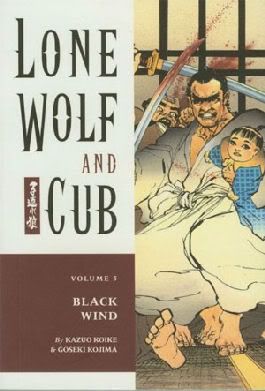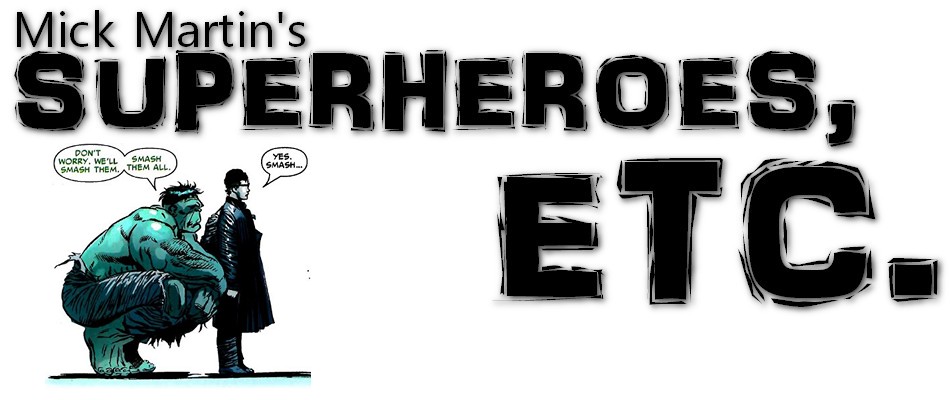 Lone Wolf & Cub Vol. 5: Black Wind
Lone Wolf & Cub Vol. 5: Black WindBy Kazuo Koike and Goseki Kojima
Published by Dark Horse; $9.95 US
288 pages
While each chapter of Lone Wolf & Cub is part of a larger story beginning with Yagyu Retsudo's framing Ogami Itto for treason and ending with the final battle between Itto and Retsudo in Lone Wolf & Cub Vol. 28: The Lotus Throne, you don't get a strong sense of that larger story in the earliest volumes. Koike and Kojima wisely introduce Itto and Daigoro in stand-alone stories, but Black Wind is where this begins to change.
Itto's war with the Yagyu clan nudges its way to the forefront in Black Wind. In fact, Black Wind's first chapter, "Trail Markers," is extremely light on story and accomplishes little else other than bringing the Ogami/Yagyu conflict into the spotlight. When the Kurokawa ninja - under Retsudo's direction - learn Itto's method of communicating with potential clients, Retsudo uses the information to send Itto's old rival Gunbei to kill him.
Though longer and certainly more satisfying, the subsequent chapter "Executioner's Hill" likewise reminds us of Itto's past. In the midst of a storm, Itto comes across six ronin, one of whom recognizes Lone Wolf as the once executioner for the Shogun. The ronin's former lord is the child Itto beheads in Lone Wolf & Cub Vol. 3: The Flute of the Fallen Tiger's flashback story "The White Path Between the Rivers."
Itto's feud with the Yagyu flares up again in "Decapitator Asaemon." The Shogun's sword-tester Yushitsugu is dispatched to kill Itto. But Yushitsugu is not just Itto's latest rival. He was the main character for Koike and Kojima's earlier series Samurai Executioner. In spite of Kojima working on both series, readers of both titles will notice Yushitsugu looks much different in Lone Wolf & Cub and it isn't tough to figure out why. So far, I only own the first three volumes of the earlier series, but a quick perusal will reveal that the Yushitsugu of Samurai Executioner is the spitting image of Ogami Itto.
"Decapitator Asaemon" is noteworthy plot-wise not only because it focuses on the Ogami/Yagyu feud, but because it is the first indication we get in the series that the Shogun is aware of the conflict, isn't pleased, and isn't necessarily much happier with Retsudo than he is with Itto.
The events which unfold in Black Wind's final chapter, "The Guns of Sakai," are crucial to the rest of the series, though it's tough to say much about it without laying down some spoilers.
Black Wind's title story is a bittersweet interlude and a relatively peaceful one. Instead of cutting through ronin or wandering the Japanese countryside looking for clients, Itto and Daigoro spend time planting rice. We are just as confused by this as the peasants who marvel at Itto's willingness to do beggar's work. We assume Itto does this as part of an assassination scheme whose puzzle pieces we can't see yet, and ultimately his motives prove to be both more and less than what we suspected.
Daigoro tugs at your heartstrings in "Black Wind." He covets the time in the paddies with his father, and finds it achingly easy to imagine an impossibility: he and his father quitting their quest for vengeance.
It brings to mind part of the reason why the Itto/Daigoro relationship works. Usually, in an action/adventure story, a child companion is a way to bring in the younger audience. To a pre-teen who fantasizes about being Batman or working alongside him, the existence of a Robin renders those fantasies a little less impossible. But this is not Daigoro's function. It is difficult to imagine a child reader envying Daigoro or wanting to fill his shoes. For better or worse, Daigoro is as much a victim of Itto's quest as Lone Wolf's doomed targets.

(Buy Lone Wolf and Cub 5: Black Wind

No comments:
Post a Comment